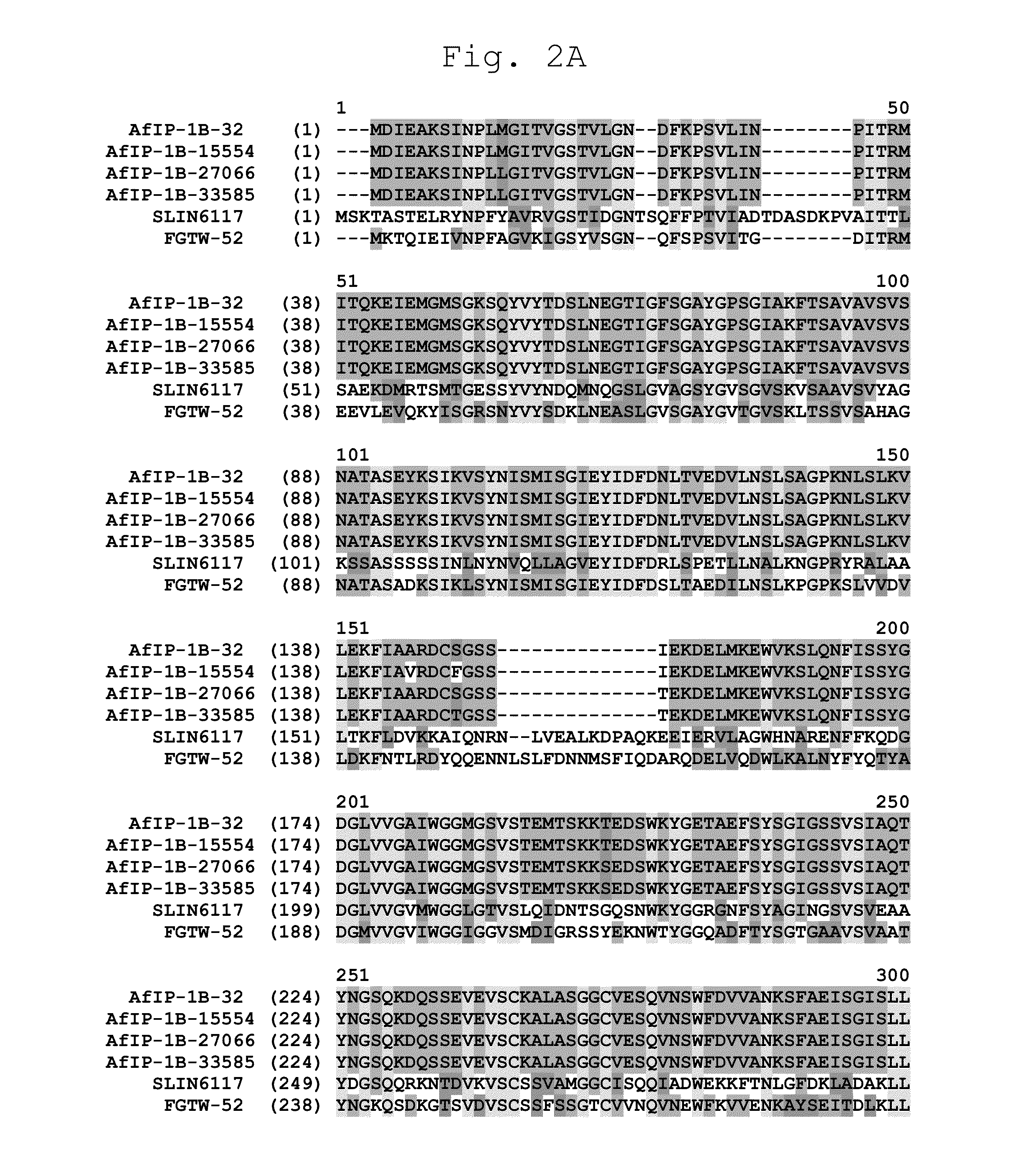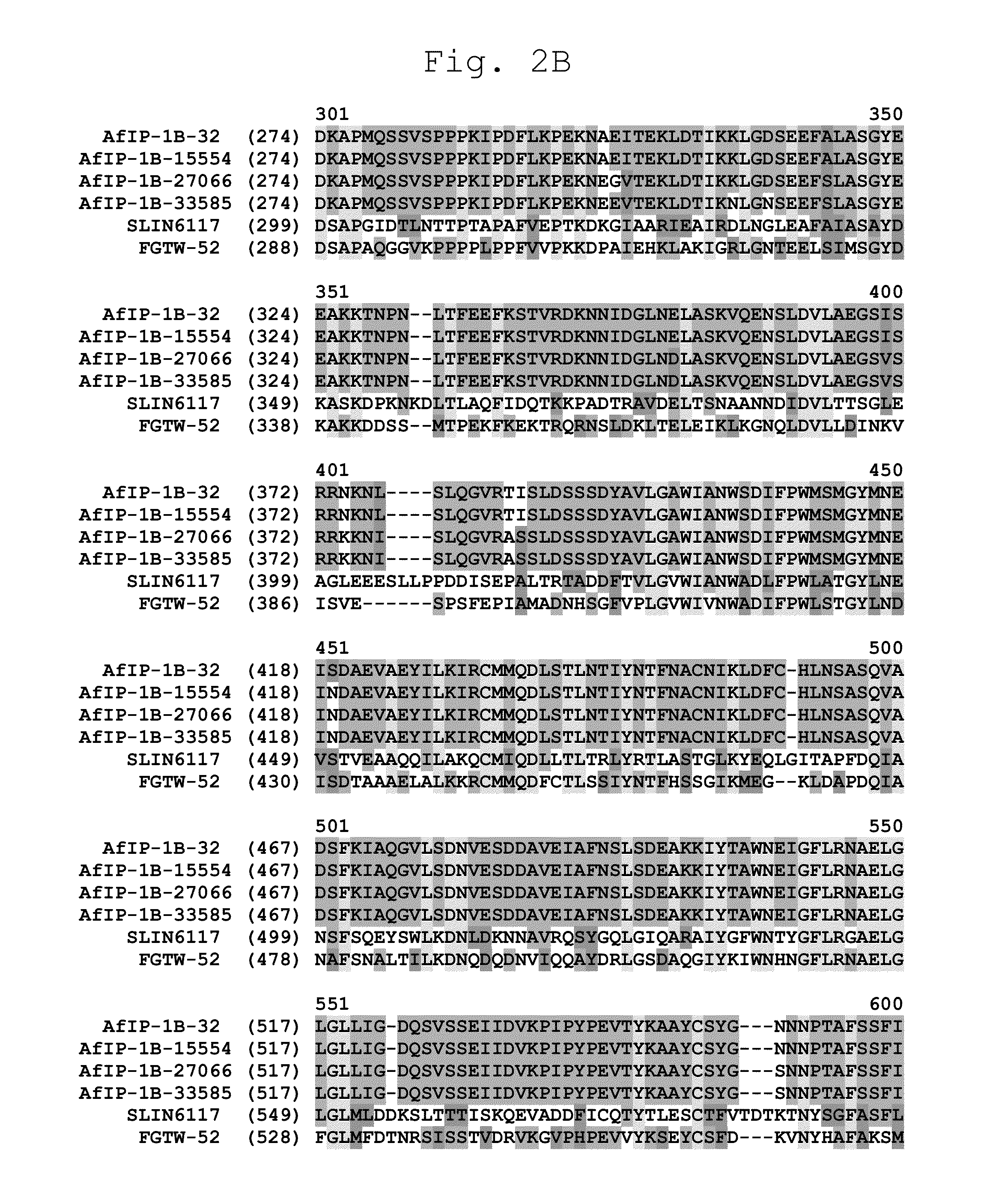Novel Insecticidal Proteins and Methods for Their Use
a technology of insecticidal proteins and methods, applied in the field of molecular biology, to achieve the effect of enhancing pest resistance or toleran
- Summary
- Abstract
- Description
- Claims
- Application Information
AI Technical Summary
Benefits of technology
Problems solved by technology
Method used
Image
Examples
example 1
Identification of an Insecticidal Protein Active Against Western Corn Rootworm from Strain DDMC P4G7
[0468]The insecticidal proteins AfIP-1A-31 and AfIP-1B-32 were identified by protein purification, N-terminal amino acid sequencing, and PCR cloning from bacterial strain DDMC P4G7 as follows. Insecticidal activity against western corn rootworm (Diabrotica virgifera virgifera, WCRW) was observed from a cell lysate of DDMC P4G7 grown in Luria Broth (LB) and cultured overnight at 28° C.
[0469]Western corn rootworm (WCRW) bioassays were conducted using the cell lysate samples mixed with molten low-melt WCRW diet (Southland Products Inc., Lake Village, Ark.) in a 96 well format. Diabrotica virgifera virgifera neonates were placed into each well of a 96 well plate. The assay was run four days at 25° C. and then was scored for insect mortality and stunting of insect growth. The scores were noted as dead, severely stunted (little or no growth but alive), stunted (growth to second instar but n...
example 2
Genomic Sequencing of AfIP-1A-31 and AfIP-1B-32
[0476]Isolated Alcaligenes faecalis strain DDMC P4G7 genomic DNA was prepared according to a library construction protocol developed by Illumina® and sequenced using the Illumina® Genome Analyzer IIx. The nucleic acid contig sequences were assembled and open reading frames were generated.
[0477]Amino acid sequence stretches identified for AfIP-1A-31 and AfIP-1B-32 by N-terminal sequencing and LC-MS / MS / MS sequencing (described in Example 1) were searched against the proteins predicted by open reading frames (ORFs) of the contig assemblies. The peptides gave perfect matches to two adjacent ORFs called ORF101 and ORF105 corresponding to AfIP-1A-31 and AfIP-1B-32, respectively. ORF101 and ORF105 were reading in the same direction and separated by 11 base pairs. Upstream of ORF101 the next ORF (265) read in the opposite direction. Downstream ORF105 there were 3 ORFs reading also in the opposite direction. It appears that ORFs 101 and 105 enco...
example 3
AfIP-1A-31 and AfIP-1B-32 Genomic Sequence & Homology Analysis
[0481]Gene identities may be determined by conducting BLAST (Basic Local Alignment Search Tool; Altschul, et al., (1993) J. Mol. Biol. 215:403-410; see also ncbi.nlm.nih.gov / BLAST / , which can be accessed using the www prefix) searches under default parameters for similarity to sequences contained in the publically available BLAST “nr” database (comprising all non-redundant GenBank CDS translations, sequences derived from the 3-dimensional structure Brookhaven Protein Data Bank, the last major release of the SWISS-PROT protein sequence database, EMBL, and DDBJ databases). The polynucleotide sequences SEQ ID NO: 1 and SEQ ID NO: 3 were analyzed.
[0482]AfIP-1A-31 (SEQ ID NO: 2) showed distant homology to aegerolysin-like proteins which have a Pfam ID#PF06355 (Reference to Pfam database: en.wikipedia.org / wiki / Pfam, which can be accessed using the www prefix). No close homologs of AfIP-1B-32 (SEQ ID NO: 3) were identified. Dist...
PUM
| Property | Measurement | Unit |
|---|---|---|
| nucleic acid | aaaaa | aaaaa |
| width | aaaaa | aaaaa |
| insect resistance | aaaaa | aaaaa |
Abstract
Description
Claims
Application Information
 Login to View More
Login to View More - R&D
- Intellectual Property
- Life Sciences
- Materials
- Tech Scout
- Unparalleled Data Quality
- Higher Quality Content
- 60% Fewer Hallucinations
Browse by: Latest US Patents, China's latest patents, Technical Efficacy Thesaurus, Application Domain, Technology Topic, Popular Technical Reports.
© 2025 PatSnap. All rights reserved.Legal|Privacy policy|Modern Slavery Act Transparency Statement|Sitemap|About US| Contact US: help@patsnap.com



